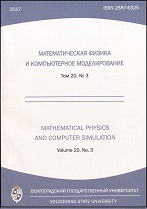|
Computer modelling
Mathematical modeling of phase-sensitive mode of radar pulse strobing scheme
V. D. Zakharchenkoa, O. V. Pakb
a Volgograd State University
b Averiya Electronics LLC
Abstract:
We study a mathematical model of the radar pulse stroboscopic transformer, which consists of a multiplier and a narrowband filter tuned to the carrier difference frequency $\Omega$. Additional capabilities of the transformer which allow extending its area of application in short radar signal phase measurements are studied. An asymptotic approach to anaysis is used which assumes a large time scale transformation factor $(N\gg1)$ and strobing radar pulses significantly shorter than input signals. It is shown that shifting the strobing pulse carrier frequency by an odd multiple of the first subharmonic of the strobing frequency allows transforming the radar signal’s phase structure into envelope modulation without employing additional phase-sensitive elements. Phase structure measurement can then be performed on a low intermediate frequency using amplitude methods. Results of seminatural modelling of the stroboscopic transformer phase-sensitive operation mode are presented, which were obtained on an experimental model built using ATmega16 and STM32F407 MCUs and a PC.
It is shown that if the clock frequency is synchronized to the second harmonic of the difference frequency $\Omega$, additional phase modulation $\Delta\theta(t)=\pi t/NT$) (appears in the signal’s complex envelope, where $T$ is the input signal repetition period, $N$ is the time scale transformation factor. As a result, this value appears to the stroboscopic processing system as carrier Doppler shift. Estimation of surplus phase $\Delta\varphi$ accumulated for the transformed signal duration $\tilde{\tau}_u=N\tau_u$ yields $\Delta\varphi=\alpha\pi$, which doesn’t depend on the spectral transformation factor $N$ and is solely determined by the signal duty cycle $\alpha=\tau_u/T$.
Keywords:
stroboscopic transformation, narrowband signal, mathematical and seminatural modelling, in-pulse phase modulation, radioimpulse strobing, phase-sensitive mode.
Citation:
V. D. Zakharchenko, O. V. Pak, “Mathematical modeling of phase-sensitive mode of radar pulse strobing scheme”, Vestnik Volgogradskogo gosudarstvennogo universiteta. Seriya 1. Mathematica. Physica, 2017, no. 2(39), 75–81
Linking options:
https://www.mathnet.ru/eng/vvgum174 https://www.mathnet.ru/eng/vvgum/y2017/i2/p75
|

| Statistics & downloads: |
| Abstract page: | 143 | | Full-text PDF : | 65 | | References: | 37 |
|




 Contact us:
Contact us: Terms of Use
Terms of Use
 Registration to the website
Registration to the website Logotypes
Logotypes








 Citation in format
Citation in format 